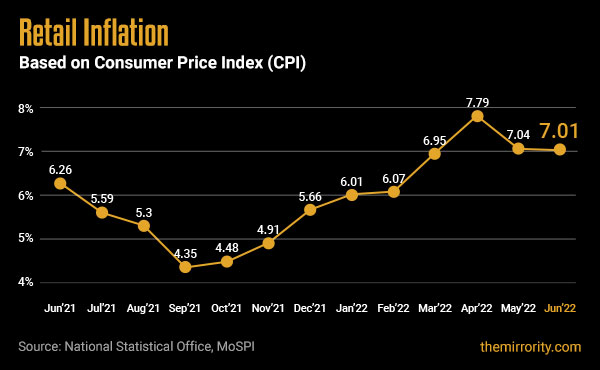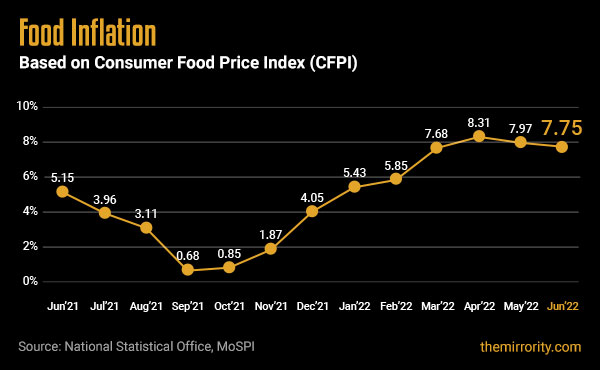
Retail inflation in India, measured by the Consumer Price Index (CPI) eased to 7.01% in June after hitting an 8-year high of 7.79% in April, based on the latest data released by the government.

The drop in inflation in June is attributed to easing crude and edible oil prices in addition to excise duty cuts on petrol and diesel. Restrictions on food exports have also contributed to easing the pressure on food items. Analysts expect the decline to be short-lived as food prices are rising due to unexpected heatwaves across the country. The risk of producers passing the higher input costs (tracked through wholesale price based inflation) onto consumers too could contribute to the retail inflationary pressures in the coming months.
At 7.01%, retail inflation in June has kept above the RBI’s comfort boundary of 6% for the sixth consecutive month. The RBI will have much explaining to do if the figure stays above 6% for one more quarter. RBI governor, Shaktikanta Das, has said recently that the current developments in Europe, primarily the Russia-Ukraine war, are impacting prices across the world and India is no exception to the price volatility. The RBI has already hiked the repo rate by 50 bps to 4.90% in its bi-monthly policy meet last month. It will have to continue to do a tightrope walk in the coming months in managing interest rates without jeopardizing the prospects of economic recovery.

Higher inflation levels due to price increases were felt particularly in Transport & Communication, which comprises 7.6% of the overall weight in the consumer price basket, with a 6.90% increase in June. Fuel & Light too recorded a price rise of 10.4% in June, in comparison to 9.54% in May. These categories have the potential to exert cost pressure on various other input items. Inflationary pressure in Housing too inched higher from 3.65% in May to 3.93% in June.
Food Inflation
Food Inflation, determined by the Consumer Food Price Index (CFPI), measures changes in retail prices of food items consumed by the population. CFPI commodities comprise 39.05% of the entire CPI basket.

Food inflation eased slightly to 7.75% in June after hitting a 17-month high of 8.38% in April. The rise in June's food inflation is a result of an increase in the prices of almost all food items. Prices of edible oil eased to 9.36% amid the Russia-Ukraine conflict as Ukraine is a major exporter of sunflower oil. Prices of vegetables increased by 17.37%, and spices increased by 11.04%. However, pulses, one of the key components of the Indian diet, contracted by 1.02% in June.
| Also read: Retail inflation statistics and expert analysis |
States-wise Inflation
.jpg)
Telangana recorded the highest level of increase in retail prices at 10.05% in Jun'22, followed by Andhra Pradesh at 8.63%. Retail price pressure was the lowest in Bihar at 4.68% followed by Delhi at 5.06%.
Reference Reading
What is retail inflation?
Retail inflation, also called consumer inflation, is a general rise in prices of consumer goods where a unit of currency effectively buys lesser goods and services, resulting in an overall drop in purchasing power in an economy over a period. More commonly, people refer to inflation as "the rising cost of living". A prolonged period of inflation occurs when a nation's money supply growth outpaces economic growth. Generally, people's perspective on Inflation differs based on their economic position. Those with tangible assets, like property or commodities, may prefer some level of inflation as that raises the value of their assets. People holding cash may not like inflation, as it erodes the value of their cash holdings. A country always aims to maintain an optimum level of inflation to promote spending to a certain extent instead of saving, thereby nurturing economic growth. In India, the Reserve Bank of India (RBI) uses consumer inflation as a key measure of inflation to set the monetary and credit policy.
How is retail inflation calculated?
Consumer inflation is based on the Consumer Price Index (CPI). It measures the weighted average of prices of a basket of 260 goods and services which are of primary consumer needs, such as food, transportation, education, fuel, etc. Changes in the CPI are used to assess price changes associated with the cost of living. Prices of sample goods and services are collected every month from 1000-1200 urban markets and villages by field staff of the Field Operations Division of NSO, MoSPI, and the change, if any, is noted. The annual percentage change in a CPI is used as a measure of inflation. Consumer price changes in India can be very volatile due to dependence on energy imports, the uncertain impact of monsoon rains on its large farm sector, difficulties transporting food items to market because of its poor roads and infrastructure, and high fiscal deficit.
The CPI basket comprising 260 commodities including certain services is grouped under 11 heads - their weightage in the basket is mentioned in brackets: Food and beverages (45.86%), Transport and communication (8.59%), Health (5.89%), Education (4.46%), Housing (10.07%), Fuel and light (6.84%), Clothing and footwear (6.53%), Pan, tobacco and intoxicants (2.38%), Household goods and services (3.80%), Recreation & amusement (1.68%), Personal care and effects (3.89%).
Example of Retail Inflation
Let's assume 1 kg of apples cost ₹ 10 in the year 2000. Thus, ₹100 could have fetched 10 kgs of apples. In the year 2020, 1 kg of apples cost ₹20 whereas ₹100 could fetch only 5 kgs of apples. Although the value of the ₹100 note remained the same, it lost its purchasing power by 50% over the 20-year period. This phenomenon is called inflation. However, it is not necessary that prices always rise with time as they may remain steady or even decline. Using the same example above, if the price of apples is reduced to ₹5 per kg in 2020, the same ₹100 note could fetch 20 kgs of apples. In this case, the purchasing power of the ₹100 note increased over the period as the price of the commodity declined. This phenomenon is called deflation and is the opposite of inflation.
TO READ THE FULL ARTICLE

Get full access to the exciting content on The Mirrority by logging in
Support independent journalism
Even the very best of media houses in our country today are yielding to the pressure of click-bait journalism in order to survive. More than ever before, our country needs journalism that is independent, fair and non-pliant to the bureaucracy. Such journalism needs the support of like-minded readers like you to help us survive editorially and financially.
Whether you live in India or India lives inside you, help us continue to produce quality journalism with your contribution.
CONTRIBUTE
